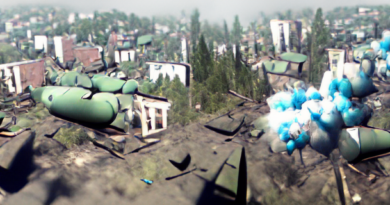A Filmmaker and a Building Superintendent, Both Looking for Truth

The super is a familiar character in New York City life. For many, the person who takes care of the apartment building remains in the periphery—like the guy at the newsstand or the bodega, or a fellow-commuter whose face you often see on the subway—a bit part in the drama where you, the tenant, are the star. In a new short documentary, “We Call Him Super,” about the building where he lives, the filmmaker Michael Patten upends this dynamic. Gerandy Balvuena is the titular superintendent. We see with his eyes and hear his voice—Balvuena is the protagonist and the narrator.
Balvuena came to the United States more than two decades ago, we learn, having left a “good job”—sitting at a desk, working on a computer—in the Dominican Republic. He wanted to finish his university education there, but life happened—he had a child on the way, along with the material demands that attend parenthood. He still wishes to finish his education someday, so he pays his matriculation fees every year, he says.
As the building super, Balvuena is involved in the residents’ lives in ways that they notice—and some that they don’t. He mops the lobby, paints the walls, puts the garbage out, snakes the drains, monitors the surveillance cameras. One time, he says, he cleaned a soiled elevator. “I don’t complain, because this job is part of my life,” Balvuena says. And that’s just it; his profession describes him, but it doesn’t define him.
Balvuena is a man of many parts, and, in the documentary, one of those stands out—his passion for making art. “Painting is how I express my soul,” his voice-over declares, as we see him working on a large canvas—a nude female form occupies the center, surrounded by swirls and blocks of écru and blue. Like many an artist, Balvuena wants to find truth. “You must change the way you see the world,” he says, “to see the truth in things.”
In one scene, Balvuena sits at a desk, with one of his art works hanging on the wall, and plays a YouTube video. It is about QAnon, the conspiracy theory slash political movement that, among its many false claims, links America’s failures to the machinations of a Democratic cabal of child-abusing cannibals. Balvuena first learned about QAnon when he looked up the Kennedy assassination—his curiosity was piqued. He’s happy he’s found Q, he says, but he doesn’t divulge the details of his conversion. “I see the world differently now,” he says.
Patten’s interest in Balvuena was roused after the filmmaker had, one day, wandered into the building’s basement, where he saw an art studio. What fascinated Patten was Balvuena’s life story, his paintings, his plans to go back to art school. But finding out, in the process, “how important Q was” to Balvuena was “shocking in the moment,” Patten told me. For Patten, that first revelation about Balvuena’s inner life—his art—was a charming one; discovering his belief in an incendiary conspiracy theory made their shared project more complicated. Ultimately, Patten thought, QAnon was part of Balvuena’s story. But can something so dangerous be left unchallenged? It is not for lack of rigor, Patten indicated, that the documentary, which never interrupts Balvuena’s narration, seems to let him off easy. “Why does he look to this for answers?” Patten said, “I think that’s what the film is trying to answer.”


